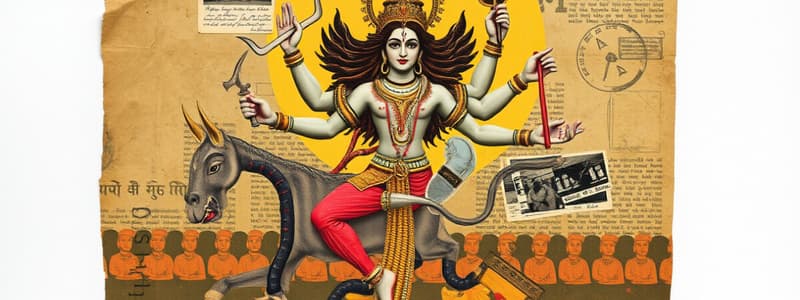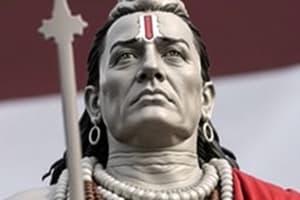Podcast
Questions and Answers
Who made the Shiva Nataraja?
Who made the Shiva Nataraja?
Cholan dynasty
When was the Shiva Nataraja made?
When was the Shiva Nataraja made?
Cholan period, circa 11th century
What medium was used for the Shiva Nataraja?
What medium was used for the Shiva Nataraja?
Copper alloy metalwork
What are the dimensions of the Shiva Nataraja?
What are the dimensions of the Shiva Nataraja?
What religion is associated with Shiva Nataraja?
What religion is associated with Shiva Nataraja?
Where is Shiva Nataraja depicted?
Where is Shiva Nataraja depicted?
Is time linear or cyclical in Hinduism?
Is time linear or cyclical in Hinduism?
What does each hand of Shiva Nataraja represent?
What does each hand of Shiva Nataraja represent?
Who is Shiva Nataraja standing on?
Who is Shiva Nataraja standing on?
What is the content of the story depicted in Shiva Nataraja?
What is the content of the story depicted in Shiva Nataraja?
How is the image of Shiva Nataraja used?
How is the image of Shiva Nataraja used?
What is puja?
What is puja?
What are the main steps in the lost wax method?
What are the main steps in the lost wax method?
Flashcards are hidden until you start studying
Study Notes
Nataraja: Shiva as the Lord of Dance
- Created during the Cholan dynasty.
- Originates from the Cholan period, circa 11th century.
- Crafted using copper alloy metalwork, a significant medium in sculptures.
Physical Attributes
- Sculpture dimensions are 26x22 inches, showcasing its impressive size.
- Depicts Shiva Nataraja engaged in dance, symbolizing the eternal cosmic cycle of creation and destruction.
Religious Context
- Central figure in Hinduism, an important religion of the Indian subcontinent.
- The dance represents the cyclical nature of time and existence, reflecting concepts of reincarnation.
Symbolism in the Dance
- Each hand symbolizes different aspects: the drum illustrates the pulse of life, while the flame represents destruction.
- The lifted foot signifies liberation, complemented by Abhaya mudra, which offers reassurance.
Iconography and Meaning
- Shiva stands on Apasmara, the dwarf symbolizing ignorance and illusion, emphasizing spiritual triumph.
- The artwork captures the essential nature of the divine, showcasing God's omnipotence and ability.
Cultural Usage
- Similar to the Da Vinci's Vitruvian Man, the image conveys balance and harmony in the universe.
Ritualistic Significance
- Puja is central to Hindu worship, involving rituals designed to heighten the awareness of the divine for both worshippers and deities.
Art Production Technique
- The lost wax method involves several steps: carving a bee wax model, adding stability struts, encasing in clay, baking to remove wax, pouring molten bronze, and finishing with smoothing and polishing.
Studying That Suits You
Use AI to generate personalized quizzes and flashcards to suit your learning preferences.




